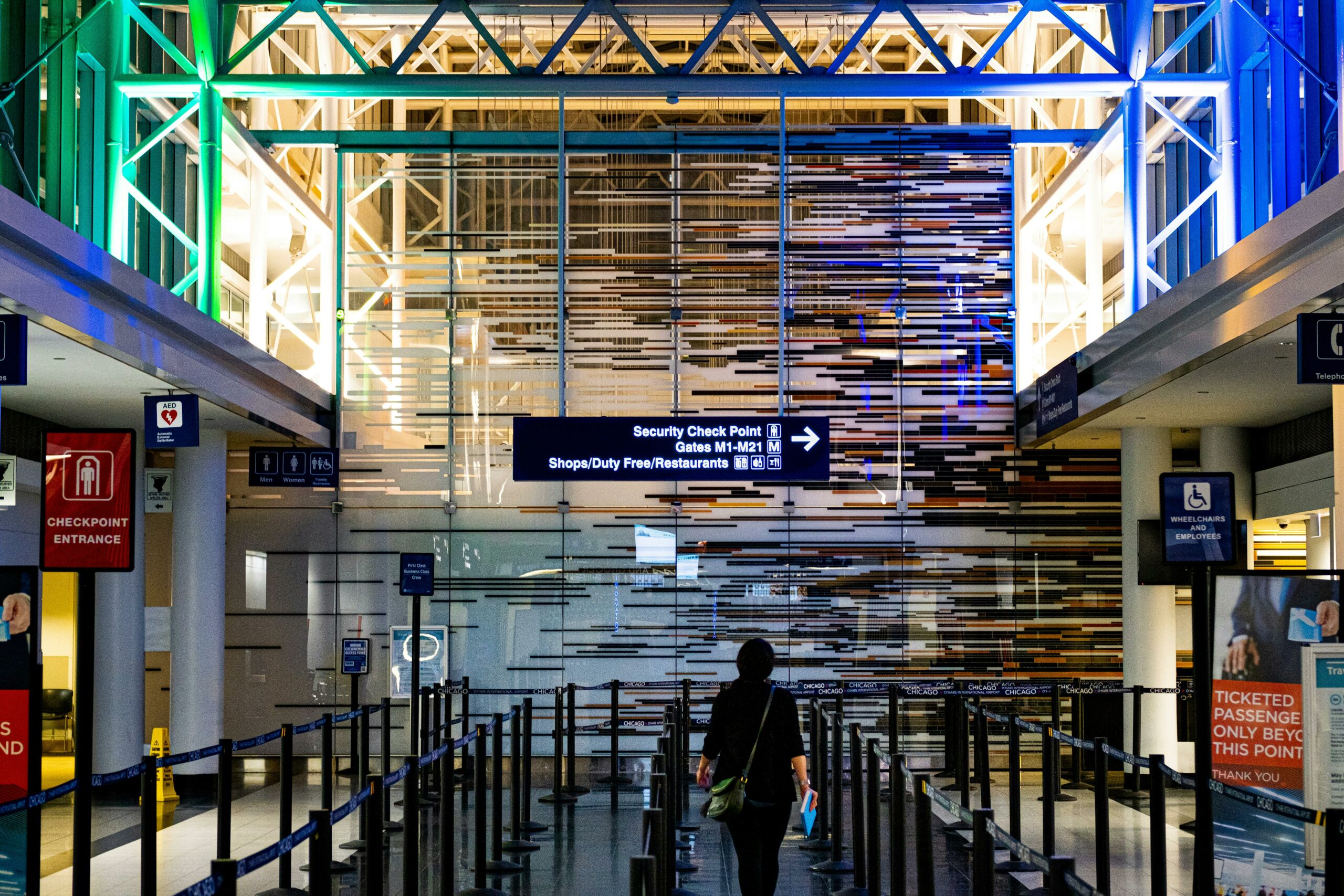In most cases, planes can fly in thunderstorms, but they typically avoid them for your comfort and safety.
In the event of a thunderstorm at your departure airport, you might experience some delays as the airport management and airlines take necessary precautions. But don’t worry, all airlines are well prepared for such weather conditions.
When you’re onboard, your flight crew continuously monitors the weather and adjusts the flight path to avoid entering thunderstorms. Modern aircraft are equipped with weather radars to detect and navigate around stormy areas. Advanced technology, like approved airborne weather radar equipment, allows pilots to detect and navigate around hazardous weather conditions, avoiding the worst parts of a storm. This means that even if you encounter thunderstorms during your flight, the plane will likely be able to adjust its route or altitude to keep you safe and comfortable.
Using a turbulence tracking tool, can help you, as someone who fears flying, better understand and anticipate turbulence events during your trips. This knowledge can give you a sense of control and prepare you for any changes in your flight experience, making it easier to face your fear and travel with confidence.
Understanding Thunderstorms and Their Impact on Flights
Thunderstorms can seem intimidating, especially when you’re about to embark on a flight. Don’t worry, we’re here to help you understand these weather phenomena and their potential impact on your trip, so you can feel more at ease with your upcoming journey.
Firstly, it’s important to know what a thunderstorm is. A thunderstorm is a complex weather event formed by a combination of warm, moist air rising and cooler air sinking. This can create rapidly changing weather conditions like heavy rain, hail, high winds, and lightning.
One major concern during thunderstorms is hail. Hailstones can grow large enough to cause damage to aircraft exteriors. However, your pilots are well-trained to deal with this and can navigate the plane away from hail.
Another issue in thunderstorms is wind shear. Wind shear refers to a rapid change in wind speed and direction, which can affect the stability of your flight. Microbursts are intense, localized downdrafts that can be hazardous to flying.
Thunderstorms can also produce heavy rain. Although planes are designed to handle large droplets and water buildup, extreme rain can impact the visibility of the pilots.
Severe thunderstorms can cause downdrafts or strong, vertical gusts of wind. These gusts can abruptly change an aircraft’s altitude. Don’t worry, your pilots are trained to deal with these scenarios, and your flight is constantly monitored to ensure your safety.
The Dangers of Flying Through a Thunderstorm
One primary concern when flying through a thunderstorm is turbulence. Turbulence, caused by rapidly changing wind speeds and directions, can be quite uncomfortable for passengers and may cause anxiety. Severe turbulence within a thunderstorm can not only be unsettling but can also cause damage to the airplane.
Another risk associated with thunderstorms is lightning strikes. Although commercial aircraft are designed to deal with lightning strikes, being struck by lightning can still be a frightening experience. Thankfully, lightning tends to strike the plane’s exterior without causing any significant damage to the aircraft, so you can rest easy knowing that your safety is not compromised.
Heavy rain and high winds associated with thunderstorms can also cause issues during the different stages of the flight, especially during takeoff and landing. Wind shear, a sudden change in wind speed and direction, can create challenging conditions for pilots trying to land the airplane safely. Additionally, hail and downdrafts within a thunderstorm cloud can also cause damage to the plane and add stress for those on board.
Modern commercial aircraft are equipped with advanced weather radar systems that help pilots and air traffic controllers navigate around severe weather, including thunderstorms. These systems help to ensure the safety of your flight and minimize the amount of time spent flying through adverse weather conditions.
Despite the potential risks, it’s essential to remember that flying in severe weather is relatively rare, and airplanes are designed to handle extreme weather conditions safely. Airlines, pilots, and air traffic controllers prioritize safety above all else and take necessary precautions to avoid flying through thunderstorms whenever possible.
In conclusion, while there are dangers associated with flying through a thunderstorm, know that your safety is of the utmost importance to those responsible for your flight. Using tools like Fly With Courage’s turbulence forecast can also help to ease your anxiety by staying informed about the weather conditions for your upcoming flight. So take a deep breath, trust the professionals, and look forward to your next journey in the sky!
How Planes and Pilots Handle Thunderstorms
Firstly, you should know that pilots undergo rigorous training to handle all sorts of weather conditions, including thunderstorms. Furthermore, planes are designed with specific features to withstand high winds and heavy rain. As a result, your airplane is more capable of flying in thunderstorms than you might initially think.
Air traffic control plays a crucial role in the safe navigation of planes during storms. They monitor weather conditions and guide pilots through the safest routes, ensuring the aircraft can always fly around the worst of the storm. This minimizes the risk of flying in adverse weather, so you can sit back and trust that you’re in good hands.
One important consideration pilots make during thunderstorms is whether it’s safe to take off or land. In extreme cases, if the weather conditions pose too much of a risk, pilots may decide to delay takeoff or divert a landing to another airport. This preventive measure ensures that you and your fellow passengers remain safe and secure.
The Impact of Lightning Strikes on Planes
When your airplane is struck by lightning, it is unlikely to cause significant damage to the aircraft. In fact, every commercial airplane in the world is estimated to be struck by lightning at least once a year. The plane’s electrically conductive exterior acts as a lightning rod, sparking a strike that could potentially damage the plane’s outer structures. However, engineers have considered this and designed airplanes to minimize the risks.
Airplanes are built with numerous protective features to counteract the effects of lightning. For example, aircraft are often equipped with lightning diverters and static dissipators to reduce the likelihood of a direct hit. Furthermore, the airplane’s fuel tanks are specifically reinforced to prevent any possible ignition due to a lightning strike.
What does this mean for you, as a frequent flyer who fears flying through thunder and lightning? Well, thanks to the engineering and safety measures implemented in modern airplanes, the risk of significant damage from lightning strikes is extremely low. Pilots are well-trained to navigate through various weather conditions, including thunderstorms, ultimately ensuring your safety.
The Role of Air Traffic Control During Thunderstorms
When flying, pilots rely on air traffic control to help them navigate through the skies safely. In the event of a thunderstorm, air traffic controllers closely monitor weather conditions and wind speed to guide your airplane along the safest possible route. They will even make adjustments to the flight path if necessary, to avoid areas of high turbulence or risks posed by lightning strikes.
Communication is key when it comes to managing flights during adverse weather situations. Air traffic control stays in constant contact with pilots, providing real-time updates on changing weather patterns and assisting with crucial decisions about whether to continue the flight, reroute, or divert to another airport.
Remember, technology is on your side too. Advanced weather tracking and forecasting systems aid air traffic control in making well-informed decisions about your flight. Tools like Fly With Courage, a turbulence forecast tool, can help you as a passenger stay informed about the turbulence levels in your flight, alleviating some of your fears.
One more thing to keep in mind is that modern airplanes are built to withstand heavy rain, high winds, and even some degrees of turbulence. Pilots undergo rigorous training to handle difficult weather conditions, and they work closely with air traffic control to ensure the safety of everyone on board.
In summary, during thunderstorms, air traffic control plays a critical role in guiding your airplane safely through adverse weather conditions. With the combined expertise of pilots, air traffic controllers, and advanced technology, you can be confident that your flight will be as safe and smooth as possible, even during the most challenging episodes of Mother Nature.
Takeoff and Landing in Thunderstorms
Airport authorities closely monitor weather conditions. If unfavorable conditions, such as low visibility or strong winds are present, a takeoff may be delayed or even canceled. This is to ensure you and your fellow passengers’ safety.
When it’s time to land, pilots follow strict guidelines to ensure a safe approach. If weather conditions deteriorate during the flight, the pilot may be directed to an alternate airport near your destination, allowing you to safely land away from the thunderstorm.
Modern airplanes have advanced systems that enable pilots to maintain control of the aircraft during turbulent conditions. Additionally, air traffic controllers assist pilots in navigating around thunderstorms, minimizing the risk of flying through them.
It’s important to remember that small planes may be more vulnerable to the effects of thunderstorms compared to larger, commercial aircraft. However, all planes—large or small—follow strict regulations to ensure the safety of everyone on board.

